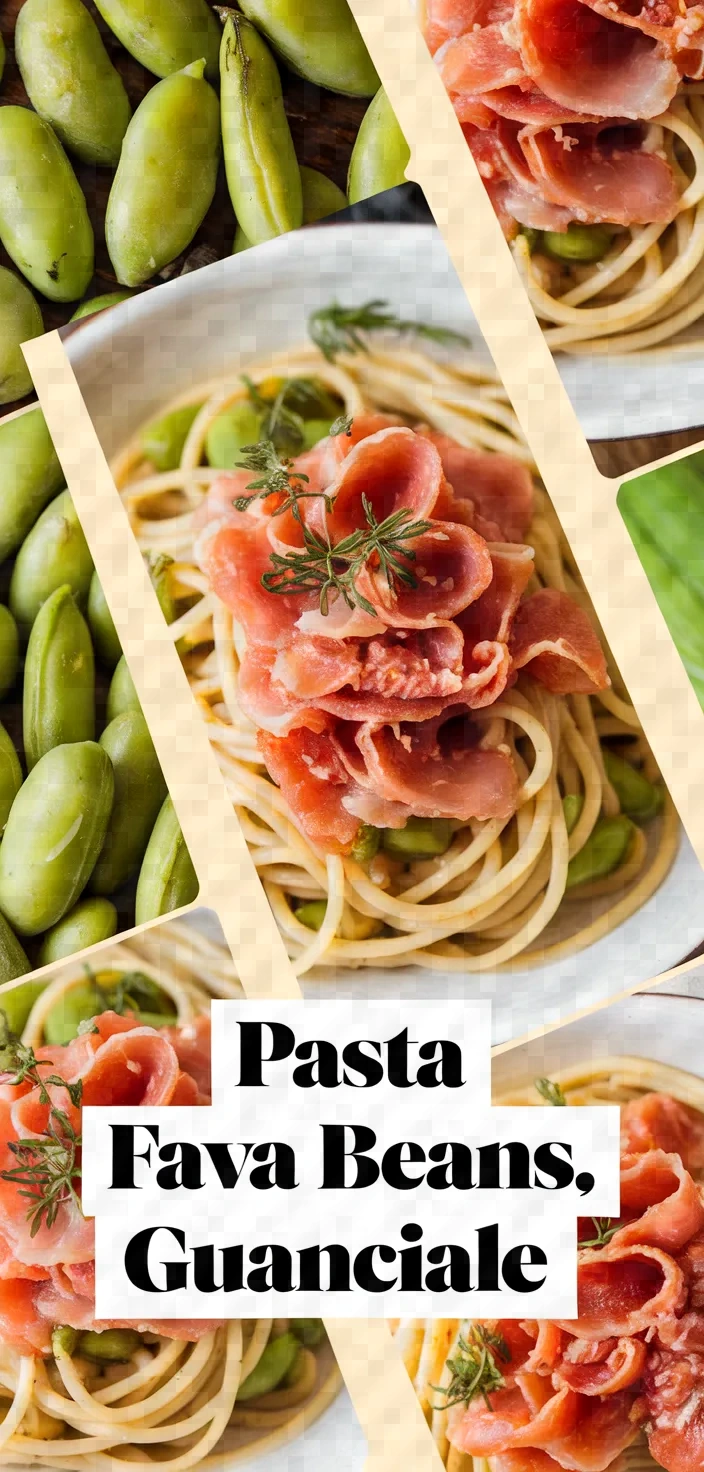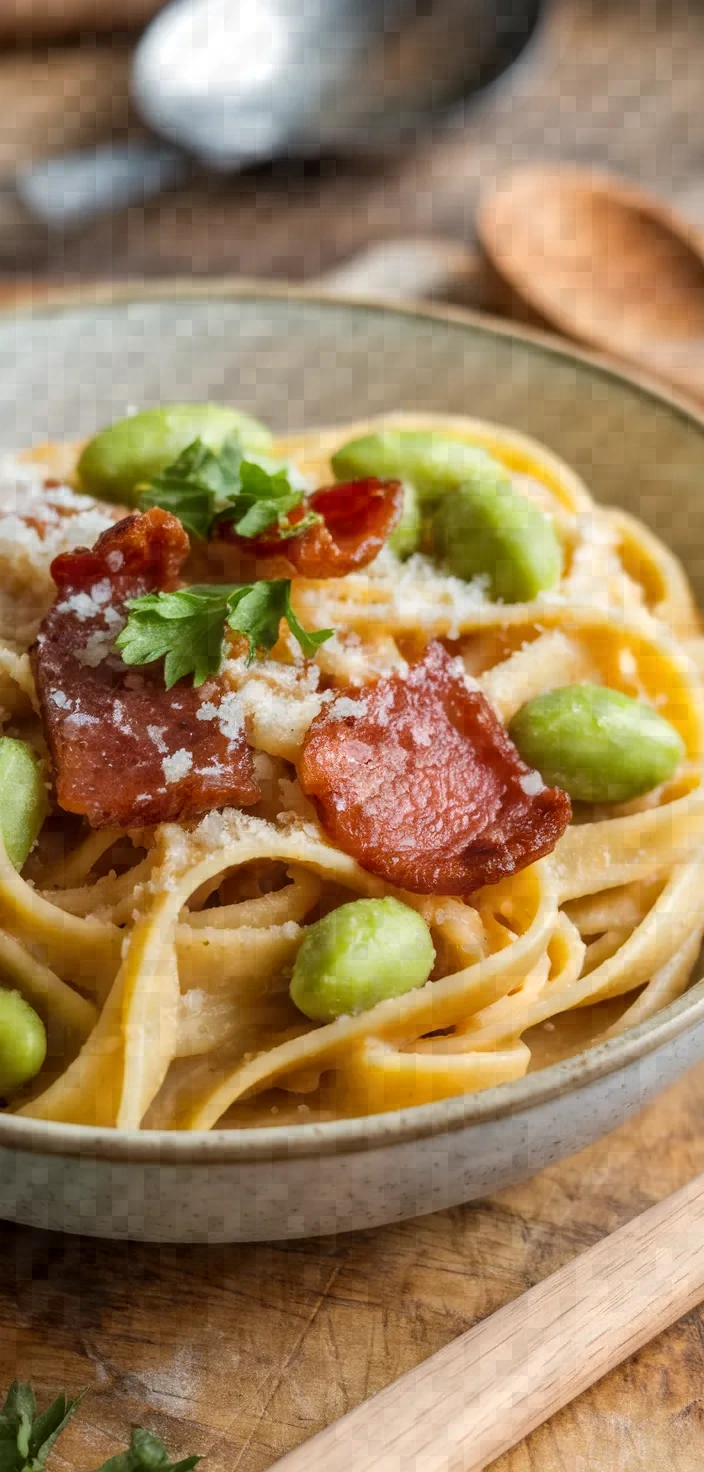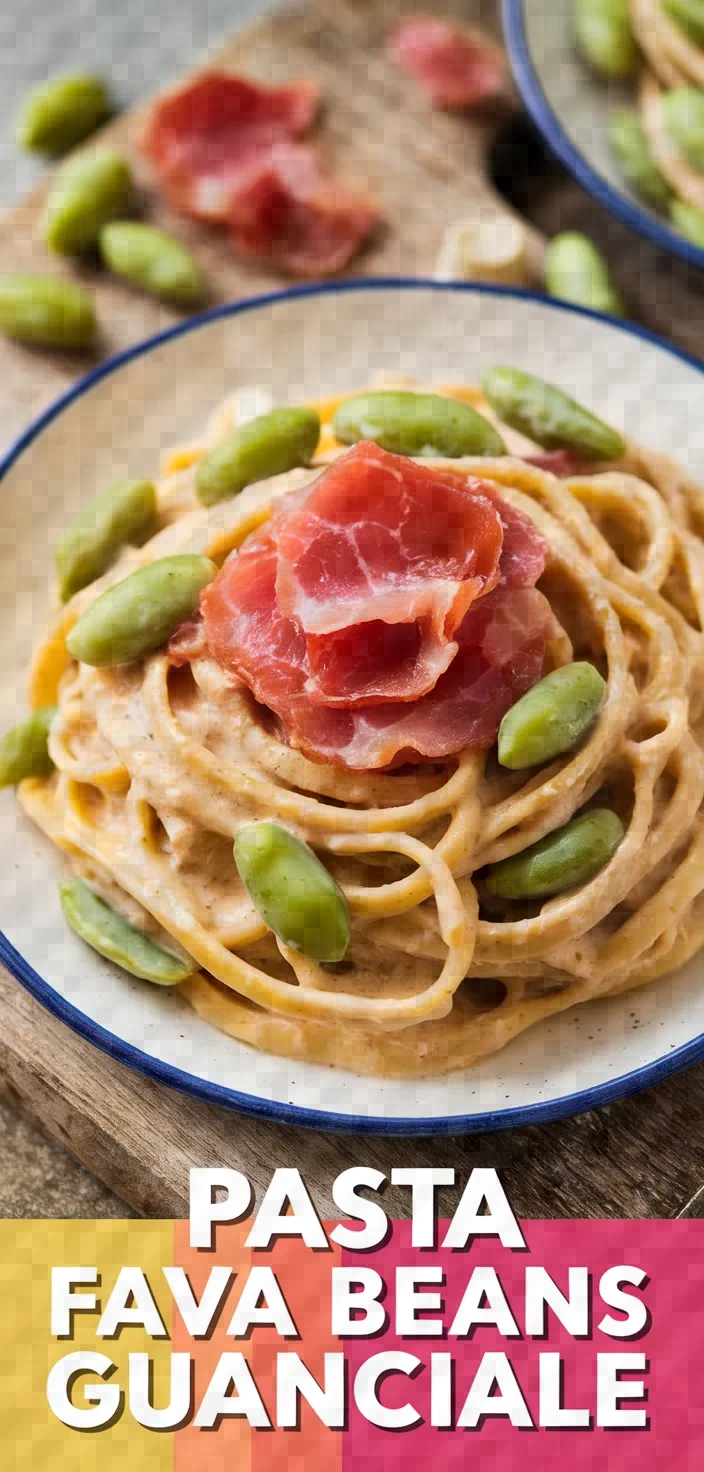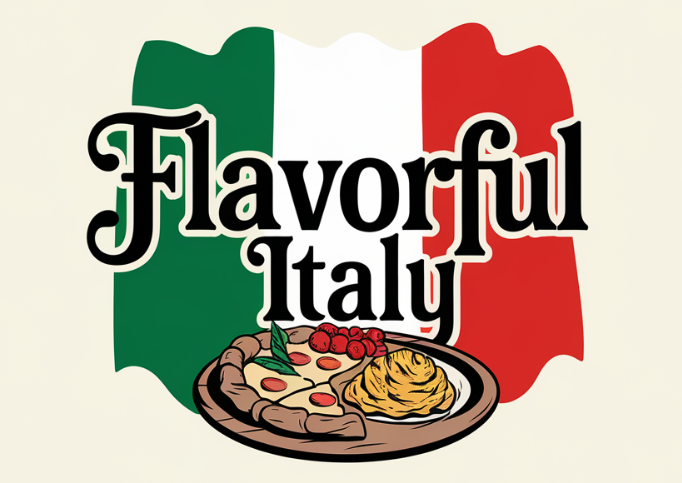As I tangled a fork through the luscious pasta, a symphony of crispy guanciale, creamy Pecorino, and vibrant fava beans danced enticingly around my senses, promising a divine experience with every bite.

Revel in the flavor harmonies of this pasta dish that melds the rich, umami-like guanciale with the bright, fresh fava beans. I adorebusing rigatoni to capture the creamy, buttery sauce that is ohso-melting good with the Pecorino Romano.
Size matters when it comes to the lemon zest. Too much and you can taste it; too little and it’s like a secret.
For me, using a Microplane to zest ensures just the right amount makes it into the sauce.
Pasta With Fava Beans Guanciale Recipe Ingredients

- Guanciale: Cured pork jowl, rich in flavor and savory goodness; adds richness.
- Fava Beans: High in protein and fiber; fresh, nutty flavor; provides creaminess.
- Pecorino Romano: Hard, salty cheese rich in umami; boosts flavor; adds savory depth.
- Lemon Zest: Bright and fragrant; adds fresh, citrusy notes; balances richness.
- Extra-Virgin Olive Oil: Healthy fat; smooth texture; enhances flavors; adds fruitiness.
Pasta With Fava Beans Guanciale Recipe Ingredient Quantities
- 12 ounces pasta (such as rigatoni or spaghetti)
- 4 ounces guanciale, diced
- 1 tablespoon extra-virgin olive oil
- 2 cups shelled and peeled fresh fava beans (or frozen, thawed)
- 1/2 cup grated Pecorino Romano cheese
- 1 tablespoon unsalted butter
- Salt and freshly ground black pepper, to taste
- 1 clove garlic, minced
- 1 teaspoon lemon zest
- Fresh parsley, chopped (optional, for garnish)
How to Make this Pasta With Fava Beans Guanciale Recipe
1. Fill a big pot with well-salted water and bring it to a boil. Stir in the pasta, and cook it according to instructions given on the package. When it’s done, resucrve 1 cup of its water, then let the pasta drain, and set it aside.
2. In a big frying pan on medium heat, place the guanciale cut into small cubes. Let it cook until its fat has melted and it is crispy, about five to seven minutes. Then, using a slotted spoon, remove it from the pan and set it aside.
3. Add the same skillet’s olive oil, then minced garlic. Sauté about 1 minute until fragrant, being careful not to burn it.
4. Add the fava beans to the skillet with the garlic, and season with salt and pepper. Cook for about 3-4 minutes until they are tender.
5. Incorporate the set-aside pasta liquid and bring it to a slow boil. Introduce the butter and allow it to fully blend into the sauce.
6. Put the pasta in the skillet and mix it together with the fava beans and garlic.
7. Guanciale, which has been crisped, is returned to the skillet, and everything is tossed together.
8. Grated Pecorino Romano, sprinkle over the pasta, and toss until the cheese melts, then thoroughly coat the pasta.
9. Incorporate the lemon zest and mix once more to ensure it is evenly distributed throughout the pasta.
10. In bowls, serve the pasta. If desired, garnish with chopped fresh parsley. Adjust the seasonings with salt and freshly ground black pepper, as needed, to make it perfect. Eat and enjoy these bountiful flavors immediately.
Pasta With Fava Beans Guanciale Recipe Equipment Needed
1. Large pot
2. Large frying pan or skillet
3. Slotted spoon
4. Wooden spoon or spatula
5. Measuring cups and spoons
6. Chef’s knife
7. Cutting board
8. Grater or zester
9. Colander or strainer
10. Mixing bowl(s) (optional for setting ingredients aside)
11. Serving bowls or plates
FAQ
- Can I substitute guanciale with another ingredient?Indeed, pancetta or bacon can be utilized if guanciale is unattainable. Nonetheless, guanciale doles out a one-of-a-kind taste that is age-old in Italian cooking.
- What is the best way to shell and peel fresh fava beans?Boil the fava beans in water for about 30 seconds, then move them to an ice water bath. This makes it easier to remove the skins.
- Can I use a different type of cheese?Although Pecorino Romano is the recommended cheese because of its sharp and tangy flavor, if you need an alternative, Parmesan is a good substitute.
- Is it necessary to use fresh fava beans, or can I use frozen ones?A convenient substitute that doesn’t compromise too much on flavor or texture, frozen fava beans are a ready-to-use alternative when fresh beans are out of season or unavailable.
- How do I prevent the pasta from sticking together?Ensure that you use ample water to boil the pasta, and stir it from time to time. You could also add a drizzle of olive oil after draining the pasta to further prevent it from sticking.
- What kind of pasta works best with this recipe?It is recommended to use rigatoni or spaghetti, but any pasta that holds sauce well, like penne or fusilli, can also be used.
Pasta With Fava Beans Guanciale Recipe Substitutions and Variations
Pancetta or bacon can be used instead of guanciale with little effect on the flavor and texture of the finished dish.
Edamame or fresh peas can be used in place of fava beans if fava beans are not available.
Parmesan cheese can be substituted for Pecorino Romano cheese when a milder flavor is desired.
Regular olive oil or avocado oil can be used in place of extra-virgin olive oil.
Lime zest can be used in place of lemon zest for a different hint of citrus.
Pro Tips
1. Pasta Cooking Water: Be sure to reserve a full cup of pasta cooking water. The starches in the water help to thicken the sauce and allow it to coat the pasta more effectively. You can use it to adjust the sauce’s consistency to your liking.
2. Perfect Guanciale Crispiness: Cook the guanciale slowly to render out the fat and achieve maximum crispiness. This not only enhances the flavor but also adds a delightful texture contrast. If guanciale is unavailable, you can substitute pancetta or a high-quality bacon.
3. Peeling Fava Beans: If using fresh fava beans, peel both the outer pod and the inner skin of the beans before cooking them. This ensures a tender and smooth texture, enhancing their flavor in the dish.
4. Cheese Finishing Touch: Reserve some Pecorino Romano to sprinkle on top of the dish just before serving for a stronger cheese aroma and flavor boost. This also gives a nice finish to the presentation.
5. Lemon Zest Freshness: Add the lemon zest at the very end to maintain its fresh citrus aroma without overshadowing the other flavors, ensuring that the zest is evenly distributed for bursts of brightness throughout the dish.

Pasta With Fava Beans Guanciale Recipe
My favorite Pasta With Fava Beans Guanciale Recipe
Equipment Needed:
1. Large pot
2. Large frying pan or skillet
3. Slotted spoon
4. Wooden spoon or spatula
5. Measuring cups and spoons
6. Chef’s knife
7. Cutting board
8. Grater or zester
9. Colander or strainer
10. Mixing bowl(s) (optional for setting ingredients aside)
11. Serving bowls or plates
Ingredients:
- 12 ounces pasta (such as rigatoni or spaghetti)
- 4 ounces guanciale, diced
- 1 tablespoon extra-virgin olive oil
- 2 cups shelled and peeled fresh fava beans (or frozen, thawed)
- 1/2 cup grated Pecorino Romano cheese
- 1 tablespoon unsalted butter
- Salt and freshly ground black pepper, to taste
- 1 clove garlic, minced
- 1 teaspoon lemon zest
- Fresh parsley, chopped (optional, for garnish)
Instructions:
1. Fill a big pot with well-salted water and bring it to a boil. Stir in the pasta, and cook it according to instructions given on the package. When it’s done, resucrve 1 cup of its water, then let the pasta drain, and set it aside.
2. In a big frying pan on medium heat, place the guanciale cut into small cubes. Let it cook until its fat has melted and it is crispy, about five to seven minutes. Then, using a slotted spoon, remove it from the pan and set it aside.
3. Add the same skillet’s olive oil, then minced garlic. Sauté about 1 minute until fragrant, being careful not to burn it.
4. Add the fava beans to the skillet with the garlic, and season with salt and pepper. Cook for about 3-4 minutes until they are tender.
5. Incorporate the set-aside pasta liquid and bring it to a slow boil. Introduce the butter and allow it to fully blend into the sauce.
6. Put the pasta in the skillet and mix it together with the fava beans and garlic.
7. Guanciale, which has been crisped, is returned to the skillet, and everything is tossed together.
8. Grated Pecorino Romano, sprinkle over the pasta, and toss until the cheese melts, then thoroughly coat the pasta.
9. Incorporate the lemon zest and mix once more to ensure it is evenly distributed throughout the pasta.
10. In bowls, serve the pasta. If desired, garnish with chopped fresh parsley. Adjust the seasonings with salt and freshly ground black pepper, as needed, to make it perfect. Eat and enjoy these bountiful flavors immediately.
